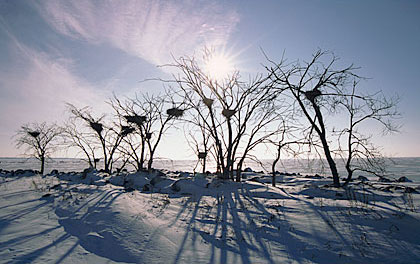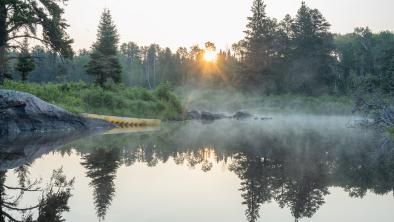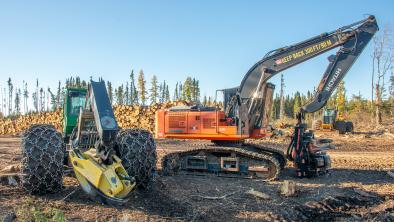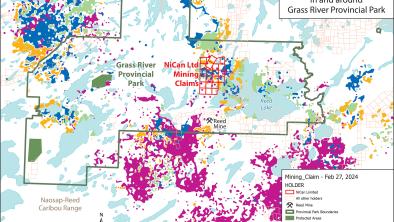Un-Reserved Protection

March 24, 2015
Manitoba’s protected natural heritage will be a little richer, again, when the government’s plan to establish five new provincial parks and another new Ecological Reserve is completed. The six areas have had interim protection as Park Reserves since 2001. These new proposals will add 24,272 hectares to Manitoba’s protected areas tally, and the six other new ecological reserve proposals recently announced will add another 10,325 hectares. Twelve areas and 34,599 hectares proposed for permanent protection this year is amazing progress!
On the shores of Lake Winnipeg, Sturgeon Bay and Kinwow Bay are wilderness regions destined to become new provincial parks, and were nominated for protection by Kinonjeoshtegon First Nation. Pelican Islands—a series of colonial bird nesting islands on Lake Winnipeg—was also nominated by Kinonjeoshtegon First Nation, and is proposed to become a new Ecological Reserve.
In Lake Winnipegosis, three more provincial parks are in order. Grand Island was a home site utilized by Chemawawin First Nation. Goose Islands and Pemmican Island are all used as nesting habitat by a variety of birds.
The Wilderness Committee has pushed for permanent preservation of these regions for nearly 10 years! WC supporters submitted hundreds of letters to the government, asking that these wilderness areas be protected. In fact, Pemmican Island was slated to have protection removed, but our voice for wilderness helped preserve it.
The province is asking for comment on the new proposals until April 1, 2015. You’ll need to email parksystem@gov.mb.ca and say YES to the government’s plan to preserve more Manitoba wilderness.
Contemplating specific steps to our 20 by 2020 goal
Manitoba still has incredible amounts of nature and wilderness, more than any of us could ever see in our lifetimes. And yet the effects of protecting our environment, the wild and nature that we have, will be easily seen in our lives: clearer water, cleaner air, and a more stable climate.
Drawing the link between a remote Manitoba wilderness that you will likely never visit and a healthier environment can be difficult. Science provides us with important facts, such as that the amount of carbon stored in the boreal forest is second to none, and that 60% of surface freshwater in the world is in the boreal. We understand that sequestering carbon, rather than releasing it is important, and fresh water needs to be protected. But what is our path forward on this?
Governments are being asked to commit to protecting half the boreal forest, and it is an excellent goal. But this high-level commitment means nothing without specific work on the ground. Ontario’s Far North Act and Quebec’s Plan Nord are both recent political commitments of protecting 50% of the boreal region. There are no timelines to completion of these targets, though, and communities on the ground are protesting the imposition of these goals without consultation. It's easy to call for such an environmental protection commitment, but that commitment has to be further enforced by individual actions—designations for specific pieces of lands and waters that are made for ecological reasons. These new protected areas are the real action we need.
The Wilderness Committee’s call to action to protect wilderness in this province has a simple yet powerful goal: protect 20% of Manitoba by 2020. It is an achievable goal, and it includes a timeline.
Protecting wild areas of Manitoba that are endangered by development is the next step to take towards our 20 by 2020 goal. Last fall the Manitoba government also protected Chitek Lake Park Reserve as a new provincial park, another great step forward, but more work needs to be done on the other areas we featured in our 2009 Conservation Hotspots report. Logging was banned in most provincial parks in 2009 but mining activity continues to destroy our parks, as you can read about in this report. And our most recent report, Wild Manitoba: 5 Natural Treasures at Risk, highlights new areas such as the Nopiming - Owl Lake Caribou Protected Area that need urgent protection. The protected area pace the Manitoba government is setting must be maintained.
Right now we have to act.
One final time, let’s tell the Manitoba government we want these areas protected!
Please email the government park planners: parksystem@gov.mb.ca (include the the premier too: premier@leg.gov.mb.ca) and tell them you support Provincial Park designation for Goose Islands, Grand Island, Kinwow Bay, Pemmican Island, and Sturgeon Bay, as well as Ecological Reserve designation for Pelican Islands.
Don’t delay, email them today and say YES to preserving Manitoba’s nature.
You can visit the Manitoba government’s Provincial Park consultation page here.
— Eric


